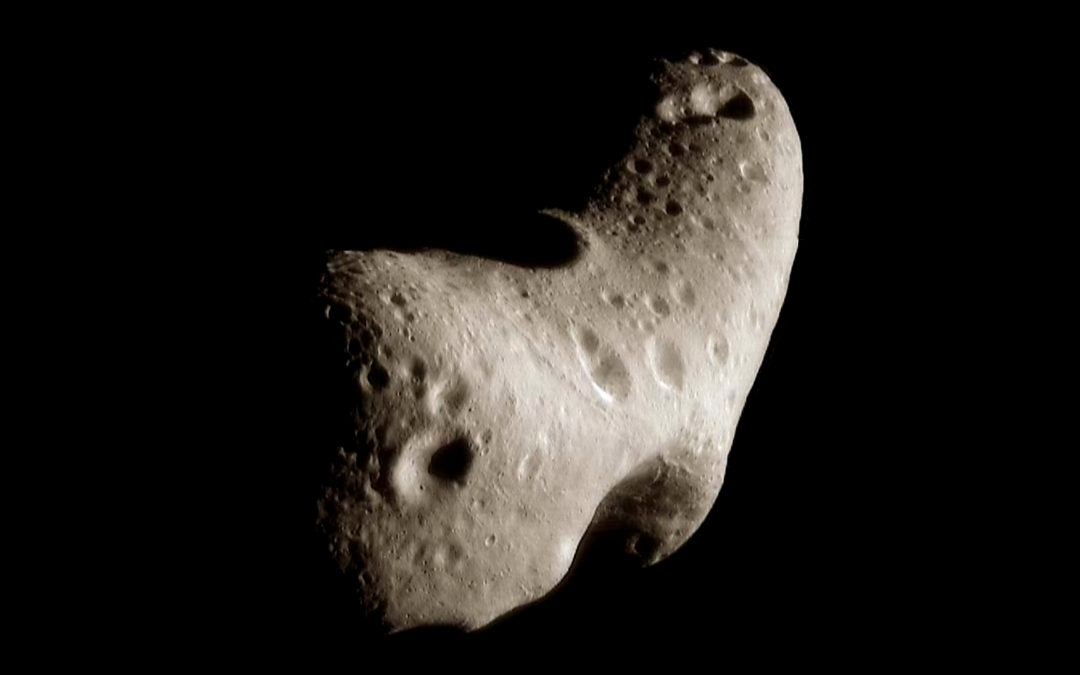On January 1, 1801, the Italian astronomer Giuseppe Piazzi discovered a new ‘planet’ in between the orbits of Mars and Jupiter. What a great way to bring in the new year! Named Ceres, this new world was far smaller than the other seven planets (Neptune had not yet been discovered). Even the most powerful telescopes of the time could not discern any sizeable disk; the object resembled a star. Piazzi initially thought that Ceres might be a comet. The central nucleus of a comet indeed looks point-like in a telescope. But Ceres was not surrounded by a coma – a cloud that typically surrounds the nucleus of a comet. Nor did it have a tail. Further observations revealed a fairly circular orbit, typical of a planet but unlike any comet.
The Discovery of the First Minor Planets
If you have never heard of the planet Ceres, that’s because it is no longer classified as a planet. It was “Plutoed” long before you were born. But even at the time of its discovery, Ceres was obviously far smaller than the other seven planets. Even in the early 1800s the question was raised, “Should it really be classified as a planet?”
On March 28, 1802, Heinrich Olbers discovered another new ‘planet’: Pallas. Like Ceres, Pallas circles the sun in between the orbits of Mars and Jupiter. In fact, their orbital periods are nearly a match. Ceres takes 4.61 years to orbit the sun, and Pallas takes 4.62 years. And, just like Ceres, Pallas shows no discernable size even in the largest telescopes of the period. William Herschel suggested that these new worlds were significantly different from the much larger planets, and therefore deserved their own new category. He suggested the term “asteroid” from the Greek meaning “star-like.” However, this term did not catch on immediately. Most astronomers continued to classify these new worlds as planets.
In 1804, Karl Harding discovered a third new ‘planet,’ which was given the name Juno. It too was “star-like” and circled the sun in between the orbits of Mars and Jupiter. The next new ‘planet’ would again be discovered by Olbers on March 29, 1807 and was given the name Vesta. Eight years of additional searching revealed no new planets, which suggested to some astronomers that perhaps there were no more. From 1807 to 1845, the solar system had eleven planets: Mercury, Venus, Earth, Mars, Vesta, Juno, Ceres, Pallas, Jupiter, Saturn, and Uranus.
Today we refer to these four “extra” worlds as “asteroids” or “minor planets.” The shift began to occur in 1845 with the discovery of yet another asteroid: Astraea. Three more were discovered in 1847, and the ninth and tenth asteroids were discovered in 1848 and 1849 respectively. Since all these new worlds were far smaller than the (other) planets, it seemed reasonable to reclassify them as minor planets, or asteroids. Both of these terms are still in use today. Since Neptune was discovered in 1846, this new taxonomy reduced the number of planets in our solar system to eight, consistent with our modern view. To date, astronomers have discovered over 963,000 asteroids in our solar system. Most are very small and far too faint to be detected by the technology available in the 1800s.
So, what is the origin of the asteroids? Early speculations that they are the remains of a planet that exploded can now be ruled out because there is insufficient mass. The total mass of all asteroids is less than that of the moon. So, if you could collect all the asteroids into one sphere, it would just be a bigger asteroid, although it would now also be classified as dwarf planet like Ceres. In fact, Ceres constitutes 25% of the mass of all asteroids. Apparently, asteroids are a unique creation by God. They were created ultimately for His glory, and perhaps for our enjoyment as well.
Properties of the First Four Minor Planets
As you might expect, the first four asteroids are among the largest in our solar system, and consequently among the brightest and most easily detected. All four orbit in between the orbits of Mars and Jupiter, which is where most asteroids are found. At the time of discovery this was thought to be very significant. Overhead depictions of our solar system reveal a pattern in the spacing of the planets, with the space between their orbits increasing with distance from the sun. But there is a noticeable gap between Mars and Jupiter, as if a planet is missing. And this is exactly where most asteroids are found.[1]

Ceres is the largest asteroid in our solar system with a diameter of 584 miles. It is the only asteroid large enough to be round under the force of its own gravity. For this reason, Ceres is also classified as a “dwarf planet” and is the only asteroid to have this distinction. So, it has dual citizenship. Ceres orbits the sun at an average distance of 2.769 AU (257 million miles) with a fairly low eccentricity of 0.076. Its orbit is inclined by 10.6 degrees relative to the ecliptic; so, it is not quite in the same plane as the planets. This is typical; asteroids tend to have higher inclinations than planets. Ceres rotates once every 9 hours, which is fairly typical for an asteroid.

Today we have beautiful images of Ceres, thanks to the Dawn spacecraft which orbited the dwarf planet in 2015. Like all other asteroids, Ceres is essentially a giant rock/ice boulder in space, with insufficient gravity to hold any substantial atmosphere. Interestingly, astronomers have discovered evidence of water vapor emissions from the surface. This may suggest internal heat. Ceres is too faint to be seen with the unaided eye, but is easily detected with binoculars when closest to Earth. A star chart will be needed since (like all asteroids) Ceres is visually indistinguishable from the background stars.
Vesta is the second largest asteroid with an average diameter of 326 miles.[2] It is also the second most massive, weighing in at about 28% the mass of Ceres. Vesta orbits the sun at an average distance of 2.36 AU (220 million miles) with a period of 3.63 years. It has relatively low orbital inclination (for an asteroid) of 7 degrees and a rotation period of 5.34 hours. Vesta is the brightest asteroid as seen from Earth. Although smaller than Ceres, it orbits closer to the sun and also comes closer to Earth than Ceres. At its closest approach, Vesta can be seen with the unaided eye under dark skies.
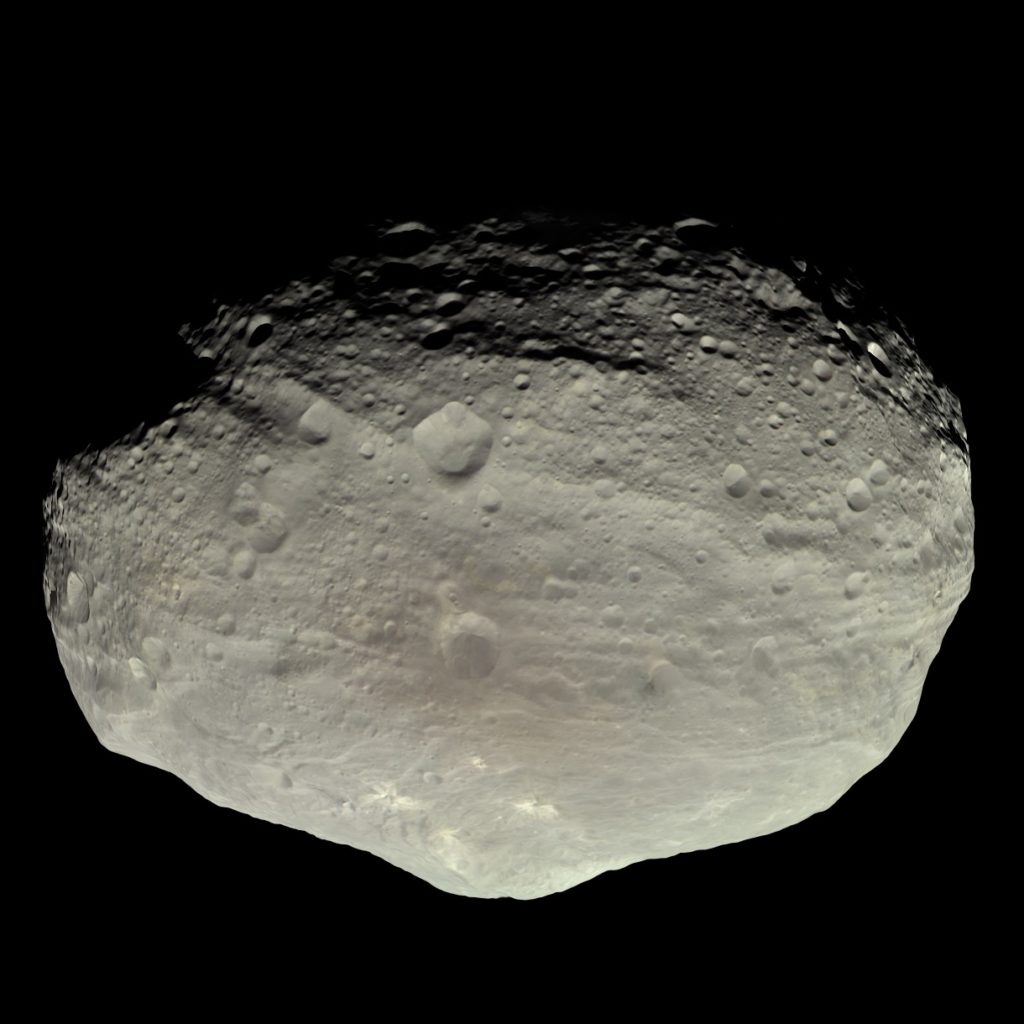


We have spectacular images of Vesta thanks (again) to the Dawn spacecraft which orbited Vesta in 2011-2012. Vesta has an ellipsoidal shape. It has a curious series of “grooves” or troughs along its equator. The largest of these troughs is over 10 miles wide in places and extends over 280 miles, comparable to Earth’s Grand Canyon.
Pallas is the third largest, and third most massive asteroid. It is approximately 320 miles in diameter. Pallas has a much higher orbital inclination than Ceres or Vesta at 34.8 degrees. Its orbit is also far more eccentric (0.23) than the fairly circular orbits of Ceres and Vesta. Pallas rotates on its axis every 7.8 hours. It also has a high axial tilt of 84 degrees, and therefore rotates on its “side” like Uranus. Since no spacecraft has yet visited Pallas, we do not have detailed images.

Juno is currently estimated to be the eleventh largest asteroid. It orbits the sun at an average distance of 2.67 AU (248 million miles), with a period of 4.36 years. It has a fairly typical inclination of 13 degrees, but has a high eccentricity of 0.255. Juno’s rotation period is typical at 7.21 hours, and its axis is tilted 50 degrees. No spacecraft has yet visited Juno, and so we have only ground-based images.

Compositional Taxonomy
As additional asteroids were discovered, it became obvious that they fell into certain categories. Since God is a God of order, many things in our universe can be classified into an organized hierarchy. There is often more than one way to do this. Asteroids are generally classified based on either their composition, or their orbital characteristics.
Based on composition, most asteroids are classified into one of three types: C, S, and M. There are further subdivisions within these categories, and there are some rare types outside these three. The C-type asteroids are the most common, constituting 75% of known asteroids. They are dark gray in color and consist of stony silicate rock with a large amount of carbon. Ceres is a C-type asteroid. Pallas is a B-type asteroid, which is sometimes considered a subcategory of the C-group.
Next most common are the S-types, which are comprised of stony silicate materials. They are generally bright in color. Juno is an S-type asteroid – one of the largest of this category. The M-types are comprised mainly of nickel-iron, and tend to be reddish in color. Vesta is a rare V-type asteroid, and is made of basalt.
The surface composition of an asteroid is estimated based on the observed color, and in many cases, by spectroscopy.[3] However, many former asteroids are available for direct inspection because they have impacted the surface of Earth – meteorites. Although M-type asteroids are the least common of the main three types, they are among the most commonly collected meteorites because their high iron easily distinguishes them from Earth rocks.
Orbital Taxonomy
Another way to classify asteroids is by their orbit. The first four asteroids all belong to the main belt. The main belt refers to asteroids that orbit in between Mars and Jupiter. Although the term “asteroid belt” may evoke images of a densely-packed region of boulders as depicted in movies like “The Empire Strikes Back,” in reality, the space between asteroids is enormous. If you were standing on one asteroid, you probably would not see another one. Yes, there are hundreds of thousands of asteroids, most of which are in the main belt. But space is vast.
Most main belt asteroids orbit prograde, with relatively low inclinations, though generally higher than the planets. However, some have inclinations of around 90 degrees, and hence orbit nearly perpendicular to the plane of the planets. A very few asteroids have inclinations greater than the 90 degrees, and hence orbit retrograde.
If you examine the average distance from the sun at which main belt asteroids orbit, you will find that there are certain distances that asteroids seem to avoid. For example, there are virtually no asteroids that orbit the sun at an average distance of 2.5 AU. The culprit is Jupiter. Jupiter is more massive than the rest of the planets combined. Hence, its gravity has a strong effect on the orbits of asteroids. Asteroids cannot orbit at 2.5 AU for any length of time because they would be in an unstable 3:1 orbital resonance with Jupiter, and would eventually be perturbed into a different orbit. Likewise, there are gaps at 2.82 AU, 2.95 AU, and 3.27 AU, each corresponding to a resonance with Jupiter. These are called the Kirkwood gaps. Additionally, there are several families of asteroids that are not confined to the main belt.
Amor class asteroids have an orbit that comes close to, but does not cross Earth, and have a perihelion distance less than 1.3 AU. As such, Amor asteroids orbit either entirely within the orbit of Mars, or (more commonly) cross the orbit of Mars. A Mars-crossing orbit does not necessarily mean that the orbits actually intersect, since they are generally in different planes. The family is named after its archetype asteroid Amor. Another notable Amor class asteroid is Eros. We have high-resolution images of Eros from the NEAR Shoemaker space probe. After analyzing Eros from orbit, the probe landed on Eros – an amazing technological feat!

Apollo class asteroids are one of two groups of Earth-crossing asteroids. Apollo asteroids have an average distance from the sun that is greater than that of Earth. Consequently, Apollo asteroids have an orbital period greater than one year. However, their elliptical orbit at times brings them closer to the sun than the Earth. The group is named after the prototype.
Aten class asteroids are also Earth-crossers, but their average distance from the sun is less than that of Earth. Consequently, they have an orbital period of less than one year. But the aphelion of an Aten asteroid is slightly farther from the sun than Earth. They are named after the asteroid Aten, the first of its class to be discovered. Earth-crossing asteroids are closely monitored since a small fraction of them actually pass relatively close to Earth at times. However, none will impact the Earth within the foreseeable future.
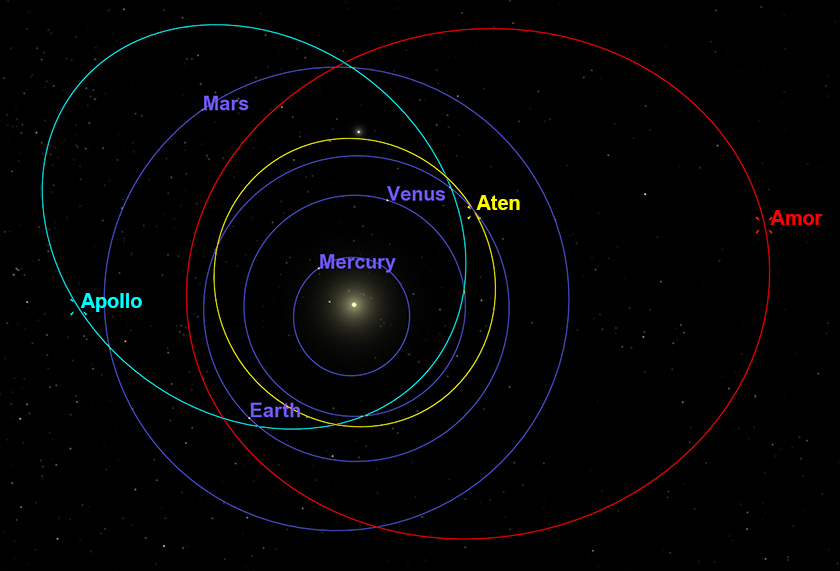
Atira class asteroids orbit entirely within Earth’s orbit. Named after the first discovered member, these are the least populated family. There are only 22 known Atira asteroids. All but one cross the orbit of Venus; the exception is entirely inside the orbit of Venus. Half of the known Atira asteroids also cross the orbit of Mercury.
Trojans
The Amor, Apollo, Aten, and Atira asteroid groups all orbit closer to the sun than the members of the main belt. But there are also asteroids that orbit beyond the main belt, and in fact share an orbit with Jupiter. These are the Trojan asteroids. They orbit either sixty degrees ahead of Jupiter, or sixty degrees behind. At such locations, a Trojan asteroid forms an equilateral triangle with the sun and Jupiter. These two locations are Lagrangian points. They are called L4 and L5 and are the only stable positions where one object may permanently share the orbit of another much more massive object.[4] Over 7000 Trojan asteroids have been discovered.
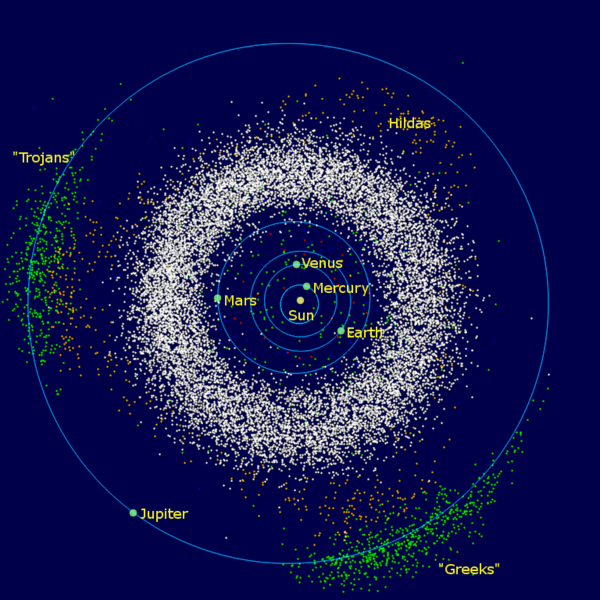
The term “Trojan” comes from the Trojan War of Greek mythology. Just as the Greeks hid inside the Trojan horse, so Trojan asteroids “hide” in the orbit of Jupiter. The first Trojan asteroid, Achilles, was discovered in 1906. Two additional Trojans were discovered within a year: Hektor, and Patroclus. Hektor is extremely elongated in shape – over twice as long as its width. It may be a contact binary: two asteroids that are stuck together and rotate around their common center of mass. It is the largest Trojan asteroid. Hektor also has a small 7-mile diameter moon named Skamandrios. Yes, asteroids can have moons.
It is customary to name Trojan asteroids after heroes of the Trojan War. Furthermore, those in the L4 group (those that orbit 60 degrees ahead of Jupiter) are named after heroes from the Greek camp, and those in the L5 group (which trails Jupiter) are named after heroes in the Trojan camp. There are two exceptions to this Greek/Trojan camp rule: Hektor and Patroclus were named before the second custom was in place, and are in the opposite camp. Hence, each camp has one “spy” from the other side. Curiously, 65% of Trojans are in the leading “Greek” camp, with only 35% in the trailing “Trojan” camp. The reason for this is unknown.
The existence of Trojan asteroids sharing Jupiter’s orbit led astronomers to ask if other planets could have Trojan asteroids sharing their orbit. Could there be a “Mars Trojan” or a “Venus Trojan?” The answer is yes, however, they are very few. Mars has 9 known Trojan asteroids. Earth has one and so does Venus. Neptune has 24 Trojans, and Uranus has two. Mercury has none, and amazingly, neither does Saturn. Ceres and Vesta each have a Trojan. So, even asteroids can have Trojan asteroids, although it is not common. If the name of the planet is not specified, the term “Trojan asteroid” refers to a Jupiter Trojan.
Hilda class asteroids are also heavily influenced by the gravity of Jupiter. They orbit the sun in elliptical paths at an average distance of roughly 4.0 AU. This puts them beyond the main belt, but inside the orbit of Jupiter, such that they are in a 3:2 orbital resonance with Jupiter. Their elliptical path brings these asteroids within the main belt at perihelion, and very near the orbit of Jupiter at aphelion. However, their orbit is synchronized such that when a Hilda asteroid is at aphelion, it will always be very near a Jupiter Lagrangian point. It will either be near L4 or L5 to temporarily join the Trojans, or on the opposite side of the sun near L3. In fact, each orbit brings a Hilda asteroid to the next Lagrangian point in the sequence: L5, then L4, then L3, and then back to L5. Consequently, at any given time, the Hilda asteroids appear to form an enormous triangle connecting these three Lagrangian points. Roughly 4000 Hilda class asteroids have been discovered. They are named after their archetype, which was discovered in 1875.
Other Notable Asteroids
Gaspra was the first asteroid to be visited by spacecraft. Consequently, it was the first asteroid for which we have high-resolution images. On its way to Jupiter, the Galileo spacecraft flew past Gaspra in October, 1990. Gaspra is 11.3 miles in length along its largest axis. It is an S-type asteroid in the main belt.
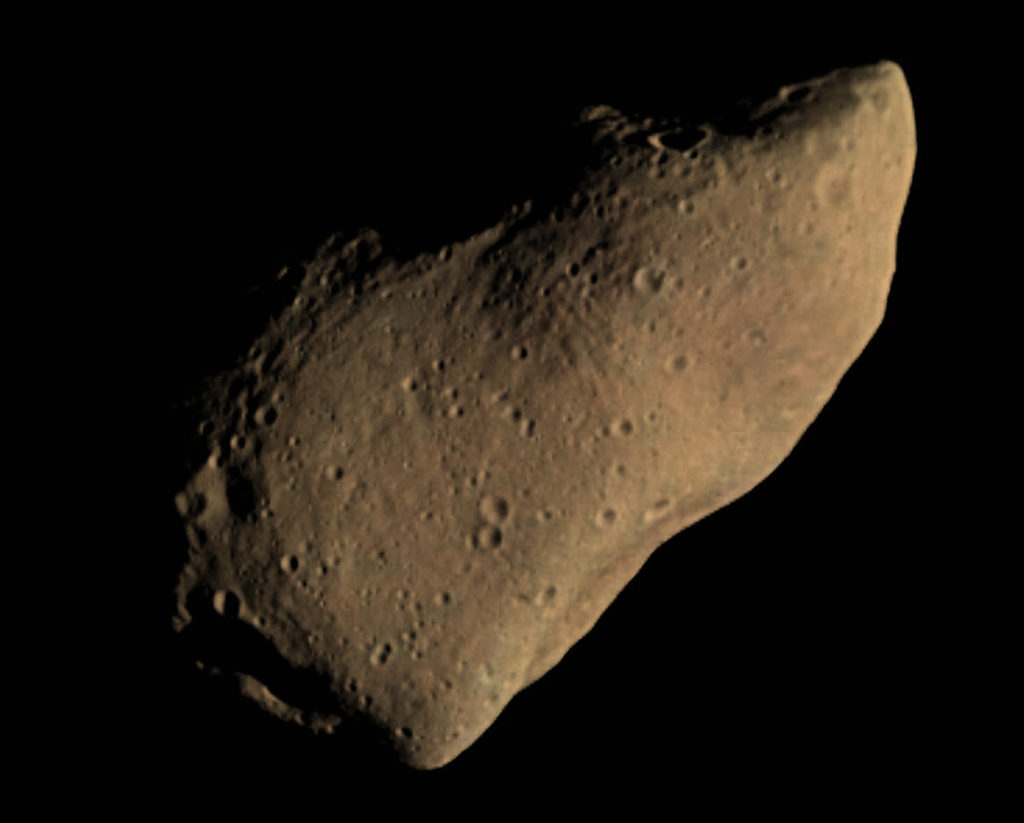
Ida was the second asteroid visited by spacecraft, and the first asteroid known to have an orbiting moon. The Galileo spacecraft flew past Ida in August, 1993, and provided high-resolution images. Ida’s moon was discovered in the images taken by Galileo, and was named Dactyl. Ida is 37 miles in length along its largest axis, and Dactyl is slightly less than 1 mile in diameter. Ida is an S-type asteroid in the main belt.

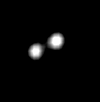
from the Keck
Observatory
Antiope was the first double asteroid to be discovered. By ‘double,’ we mean that it has a “moon” that is nearly as large as the primary. The larger component is 55 miles in diameter, whereas the smaller component is 52 miles in diameter. They orbit each other around their common center of mass every 16.5 hours. Both components are C-type asteroids in the main belt.
Patroclus was the third Trojan asteroid to be discovered, and in 2001 it became the first known double Trojan. That is, Patroclus has an orbital companion of roughly the same size named Menoetius.
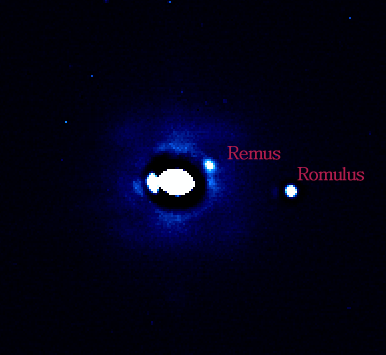
Sylvia was the first asteroid found to have two moons, which have been named Romulus and Remus. It is a main belt asteroid. Sylvia is currently estimated to be the eighth largest asteroid in the solar system.
Toutatis is an S-type, Apollo class (Earth-crossing) asteroid with a very unusual property: it rotates chaotically. Like Saturn’s moon, Hyperion, Toutatis does not have a fixed rotation axis. Instead, the rotation axis cycles along the surface of the asteroid with a period of 7.38 days. And the asteroid rotates about this axis once every 5.38 days. The combination of these two periods results in the “tumbling” behavior of this asteroid. Toutatis is highly elongated with two lobes; its unusual shape contributes to its chaotic rotation. Toutatis orbits very nearly in a 3:1 resonance with Jupiter, which is near a Kirkwood gap. Consequently, its orbit is also slightly chaotic, and will eventually change.
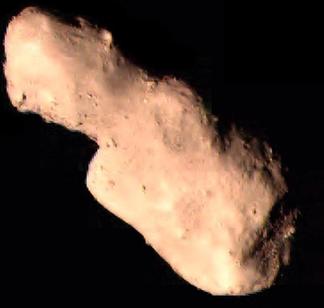
Unlike most Apollo class asteroids, Toutatis orbits in nearly the same plane as the planets, and consequently occasionally passes relatively close to Earth. This has allowed ground-based observatories to map the shape of Toutatis using radar. It was also visited by the Chang’e 2 spacecraft. Close passes of Toutatis occurred in December 2012, and again in 2016. However, the next close pass will not occur until 2069.
More to Come
As technology progressed, astronomers were able to detect objects as small as asteroids at increasingly greater distances. This led to the discovery of Chiron in 1977. This unusual asteroid orbits beyond the distance of Saturn. As such, it does not belong to any of the previously known groups. Moreover, subsequent observations revealed that Chiron is sometimes enveloped in a faint cloud, much like the coma of a comet. But, unlike a comet, the orbit of Chiron never brings it close to the sun. It is yet a new type of object? We will explore this issue in the next article. Clearly, there is more yet to explore in our solar system.
[1] The distances of the planets from the sun are approximated by a mathematical rule, sometimes called the Titius-Bode law. It gives the distances of the planets as a=(4+x)/10 where x=0,3,6,12,24,48…. These distances are given in AUs, where 1 AU is defined to be Earth’s distance from the sun. This law works well for all the planets known in 1800, except for the anomalous gap between Mars and Jupiter. When the first asteroids were found in this gap, it seemed to confirm the Titius-Bode law, which perhaps bolstered their initial classification as planets. The discovery of Neptune challenged such thinking, since it does not follow the Titius-Bode law. Today, the “law” is viewed as an interesting coincidence with no theoretical justification.
[2] In some literature, you may find Pallas listed as the second largest asteroid. However, the latest estimates show that Vesta is very slightly larger than Pallas.
[3] Spectroscopy is the breaking of light into its constituent wavelengths. The relative strengths of the various wavelengths reveal the composition of the source.
[4] There are five Lagrangian points: locations where the gravity of the sun and planet balance with a third object in the rotating frame. The first three points, L1, L2, and L3 are unstable, meaning a slight departure from those positions will result in further deviation, eventually resulting in the object being ejected from that orbit. L1 is in between the sun and planet, but closer to the planet. L2 is just beyond the planet (on the opposite side of the planet as the sun). L3 is on the opposite side of the sun as the planet, and at roughly the same distance. L4 and L5 are stable, meaning a slight departure from those positions results in the objecting being gently pulled back toward the point, often forming a horseshoe orbit around the point.

